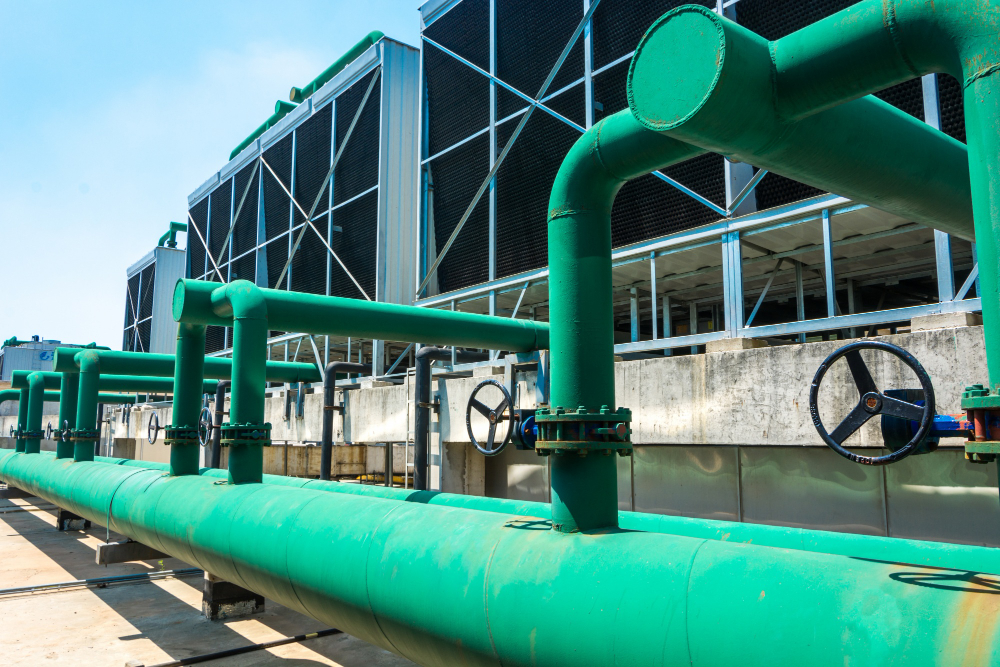4.7.2 Lecture Notes Industry Perspective
Course subject(s)
4. Intelligent Control and Integration of Heating in the Energy Systems

This image is from freepik
This lecture will discuss the district heating network of the TU delft campus and it will be shown how different heat aspects are combined in practice. The following topics will be covered:
- The development of a sustainable District Heating Network (DHN)
- High Temperature Aquifer Thermal Energy Storage (HT-ATES) for seasonal storage
- Heat pump facility
- The challenges involved with District Heating Network development
The development of a sustainable District Heating Network
The heat demand of the TU Delft has a peak value of 27 MW, which happens somewhere in the winter. Furthermore, there is a period with no heat demand in the summer, which is due to the holiday break. The total heat demand in a year is 200 TJ.
Currently, the District Heating Network (DHN) is fed with heat from gas fired boilers and a Combined Heat and Power (CHP) unit. In the future, this will partly be replaced by geothermal energy. The geothermal well will be used to provide sustainable heat from the campus, and it will be used for research and development purposes. Since the geothermal well only provides a base load, it is not able to provide heat for the peaks.
In total, 235 TJ of energy could be produced by the geothermal well if it would be operating at full capacity, which is more than the needed demand of 200 TJ. However, due to the mismatch in demand and availability of heat, only 135 TJ can be delivered directly. To close this gap, large scale seasonal storage needs to be applied.
High temperature aquifer thermal energy storage To bridge the seasonal mismatch, High Temperature Aquifer Thermal Energy Storage (HT-ATES) can be used. This improves the total delivery of the geothermal well to the DHN, which therefore results in a better utilization of the sustainable geothermal well.
During the summer, heat is stored in the HT-ATES, and this heat can be used in the winter. By combining the HT-ATES with a 7 MW thermal power output and a seasonal storage of 50 TJ, the net energy shortage is reduced to 15 TJ. This reduces the dependence on conventional energy sources.
The heat pump facility
Another important component is the Heat Pump Facility. This facility has two installed heat pumps with a heating capacity of 21 MW and has two main purposes. The main goal of the heat pump is to ensure the supply of the required temperature. The other goal is to extract heat from the DHN return steam, such that the injection temperature of the geothermal well is lower. Therefore, ΔT is increased and therefore the yield is improved.
The challenges for the DHN
The future activities of the DHN project in delft are the following:
- The geothermal well and the heat pump station need to be realised.
- The existing and the new DHN need to be connected
- The HT-ATES needs to be connected for a better utilization of the geothermal well.
- Different parties need to be brought together, which are involved in the development of the DHN.
In this development, there are various complexities that introduce challenges. This are the most important ones:
- The matching of supply and demand: This increases the utilization of the resources and reduces the dependence on conventional energy sources.
- Working with different parties: There are different stakeholders involved, which increases the complexity of the project.
- Making decisions: Because there are multiple stakeholders, all decisions need to be aligned with all their interests.
- Rigid subsidy schemes: The subsidy of this project is offered by the government. Since it is limited, this adds additional complexity to the project.

Technology of Intelligent and Integrated Energy Systems by TU Delft OpenCourseWare is licensed under a Creative Commons Attribution-NonCommercial-ShareAlike 4.0 International License.
Based on a work at https://online-learning.tudelft.nl/courses/technology-of-intelligent-and-integrated-energy-systems/



